How Long Does Fresh Ground Peanut Butter Last
Fresh ground peanut butter's shelf life depends heavily on your storage method. When refrigerated in an airtight container, it'll last 1-3 months, but at room temperature, it only stays fresh for a few days. You'll want to watch for signs of spoilage like darkening, unusual odors, texture changes, or a bitter taste. Always use clean utensils and store your peanut butter in glass or BPA-free plastic containers with tight-fitting lids to prevent oxidation and moisture damage. While oil separation is normal and can be fixed by stirring, any mold growth means you should discard the product immediately. Proper storage techniques can greatly extend your peanut butter's freshness and quality.
This post may contain affiliate links. If you make a purchase through these links, I may earn a commission at no additional cost to you. Additionally, portions of this post may be generated using artificial intelligence (AI) technology. While we strive for accuracy, please be aware that AI-generated content may not always be perfect and should be fact-checked when necessary.
The Spatula Scoops
- Fresh ground peanut butter lasts 1-3 months when stored properly in the refrigerator at temperatures below 40°F (4°C).
- At room temperature, fresh ground peanut butter only remains fresh for a few days before quality deteriorates.
- Store in airtight glass or BPA-free plastic containers with tight-fitting lids to prevent moisture and oxidation.
- Monitor for signs of spoilage including darkening, unpleasant odors, texture changes, bitter taste, or mold growth.
- Oil separation is normal; stir before use and consider storing containers upside down to maintain consistency.
Shelf Life Basics
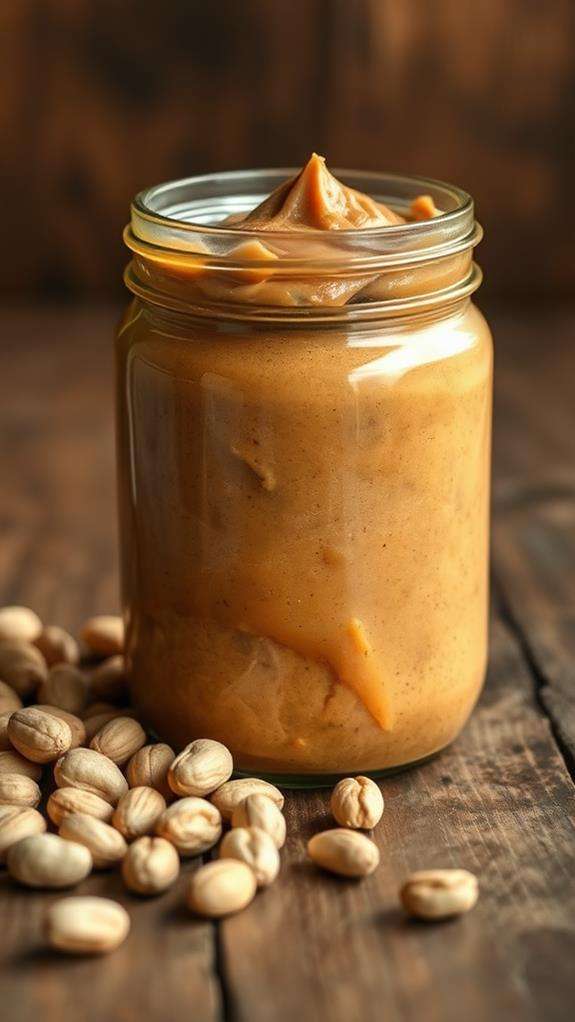
Fresh ground peanut butter's shelf life depends heavily on your storage methods and handling practices. When you're storing your freshly ground peanut butter in the refrigerator, you can expect it to maintain its quality for about 1-3 months, provided you're keeping it in an airtight container. This timeframe greatly drops when you leave it at room temperature, where it'll only stay fresh for a few days.
You'll want to pay close attention to how you're storing your peanut butter to maximize its shelf life. When you open your container, make sure you're sealing it properly after each use, as exposure to air can speed up deterioration. You should also keep it away from direct sunlight and heat sources, which can cause the oils to separate and potentially turn rancid more quickly. As you're using your peanut butter throughout the months, regularly check for any changes in smell or texture. If you notice any off-putting aromas or unusual consistency changes, it's time to replace it. Remember, proper refrigeration is your best defense against premature spoilage, especially if you're planning to keep it for more than a few days.
Storage Methods That Work
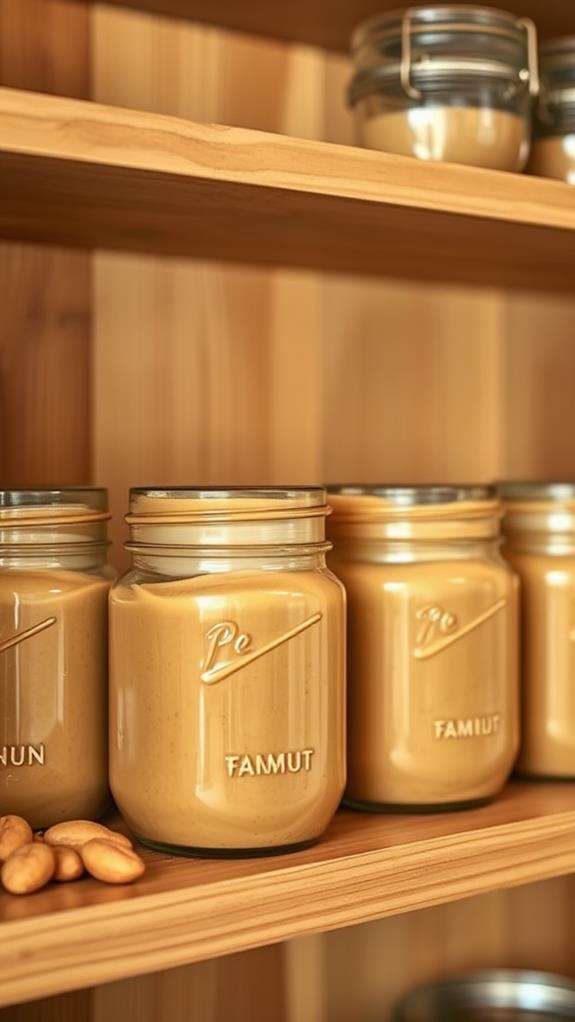
Proper storage methods can greatly extend your ground peanut butter's shelf life. When you store peanut butter correctly, you'll protect it from factors that cause spoilage and maintain its quality for up to three months. You'll want to transfer your freshly ground peanut butter to an airtight container immediately after purchase or grinding.
| Storage Method | Benefits | Duration |
|---|---|---|
| Refrigeration | Prevents rancidity, maintains freshness | 1-3 months |
| Airtight Container | Blocks moisture, prevents oxidation | Essential for all storage |
| Dark Location | Protects from light damage, maintains quality | Entire storage period |
To maximize your peanut butter's shelf life, you'll need to keep it away from heat sources and direct sunlight. Don't leave it in its original packaging, as these containers often lack proper sealing mechanisms. Instead, opt for glass or plastic containers with tight-fitting lids. You should regularly check your stored peanut butter for any unusual odors or changes in texture. If you notice any off-putting smells or significant separation, it's time to replace your supply. Remember to always use clean utensils when scooping out portions to prevent contamination.
Signs of Spoilage
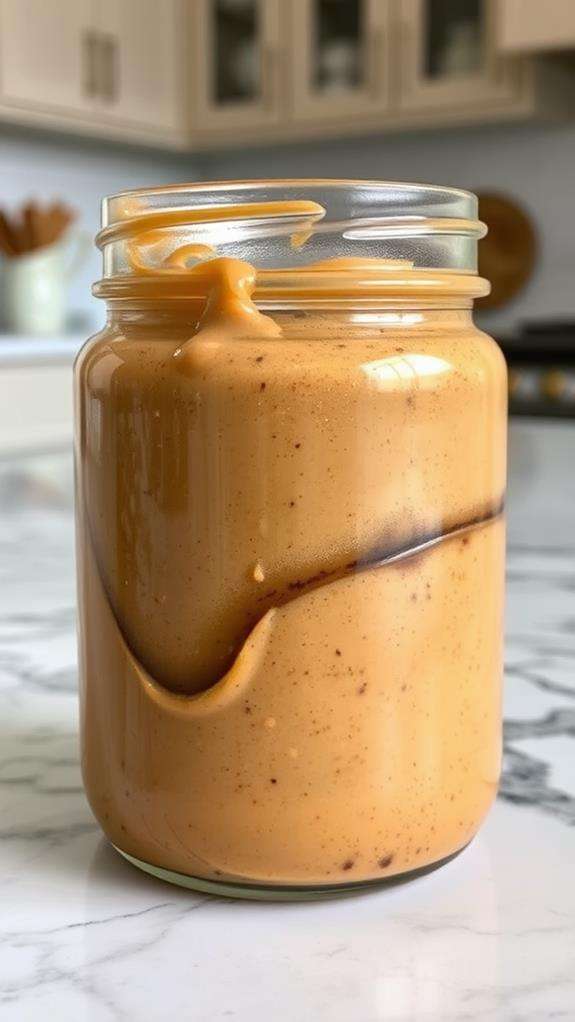
When checking your fresh ground peanut butter for spoilage, you'll want to look for obvious visual changes like unusual darkening, streaks, or any discoloration that appears alongside natural oil separation. Your nose can be one of your best tools, as spoiled peanut butter will give off a distinctly unpleasant odor that's quite different from its natural nutty aroma. If you're still unsure, you can rely on texture and taste indicators, where excessive dryness, unusual crumbling, or a bitter flavor instead of the expected nutty taste means it's time to discard the peanut butter.
Visual Warning Signs
Keeping an eye out for visual warning signs is crucial to determine if your fresh ground peanut butter has spoiled. When examining your peanut butter, you'll want to check for specific visual cues that indicate potential spoilage. While oil separation is normal and can be easily remedied by stirring, other changes should raise immediate concerns.
| Warning Sign | What to Look For | Action Required |
|---|---|---|
| Color Changes | Dark brown or unusual discoloration | Discard immediately |
| Texture Issues | Dry, crumbly consistency | Evaluate freshness |
| Mold Growth | Any spots or fuzzy patches | Discard immediately |
| Oil Separation | Layer of oil on top | Stir to redistribute |
You'll need to monitor your fresh ground peanut butter's appearance regularly, as visual changes often precede other spoilage indicators. If you notice the texture becoming unusually dry or crumbly instead of maintaining its creamy consistency, it's likely past its prime. The most concerning visual indicator is mold growth – even if it's just a small spot, you shouldn't take any chances. Remember that proper storage in the refrigerator can help maintain freshness for up to three months, but you should still rely on these visual indicators to guarantee safety.
Smell and Taste Changes
Beyond visual inspection, your nose and taste buds serve as powerful tools for detecting spoiled fresh ground peanut butter. When you're evaluating your peanut butter's freshness, you'll want to pay close attention to its characteristic nutty aroma, which should be pleasant and reminiscent of roasted peanuts. If you notice a sour, sharp, or rancid smell, it's a clear indicator of spoilage and means you shouldn't consume the product.
Your taste buds can also alert you to potential problems before they become visible. Fresh ground peanut butter should have a rich, creamy flavor that's naturally sweet and nutty. If you detect any bitter, metallic, or off-putting tastes, don't ignore these warning signs. They're reliable indicators that spoilage has begun, even if you can't see it yet. When conducting your taste test, start with a tiny amount on the tip of your tongue – there's no need to consume a large portion if the product has gone bad. Remember to trust your senses; if something doesn't smell or taste quite right, it's better to err on the side of caution and dispose of the peanut butter.
Refrigeration Vs Room Temperature
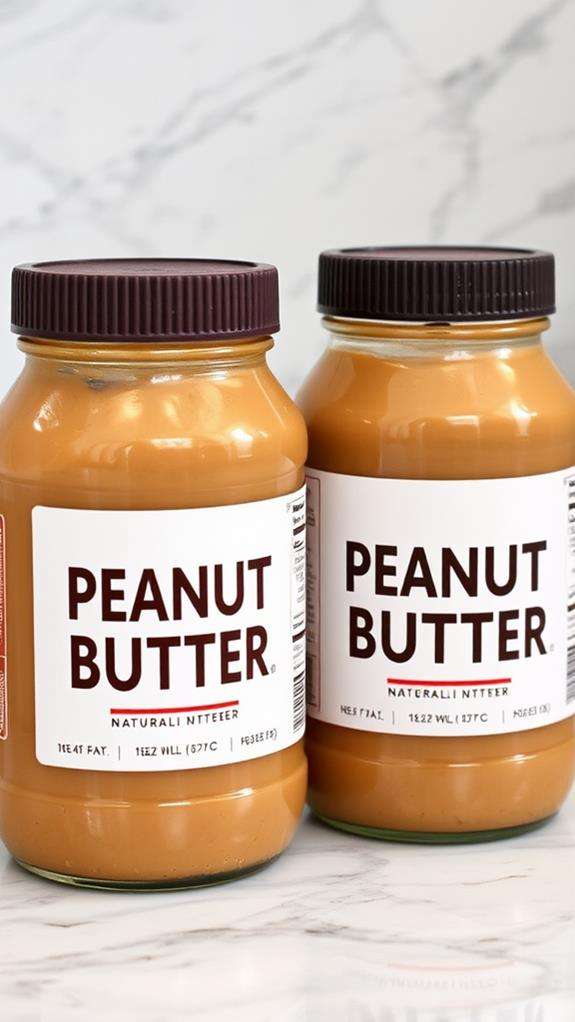
The storage decision between refrigeration and room temperature greatly impacts how long your fresh ground peanut butter will last. If you're looking to maximize shelf life, refrigeration is your best option, as it can keep your peanut butter fresh for up to three months. When you store it at room temperature, you'll notice quality changes within just a week.
To make the most of your fresh ground peanut butter's lifespan, consider these key storage factors:
- Temperature control through refrigeration notably reduces the risk of oils becoming rancid
- Airtight containers protect against moisture and oxidation, particularly important during refrigerated storage
- Room temperature storage accelerates spoilage and flavor changes, making refrigeration the superior choice
You'll want to keep your fresh ground peanut butter in the refrigerator if you're not planning to consume it within a week. While room temperature storage might be more convenient for spreading, it's not worth compromising the quality and shelf life of your product. By choosing refrigeration, you're ensuring that your peanut butter maintains its nutritional value, flavor profile, and overall freshness for an extended period.
Proper Container Selection
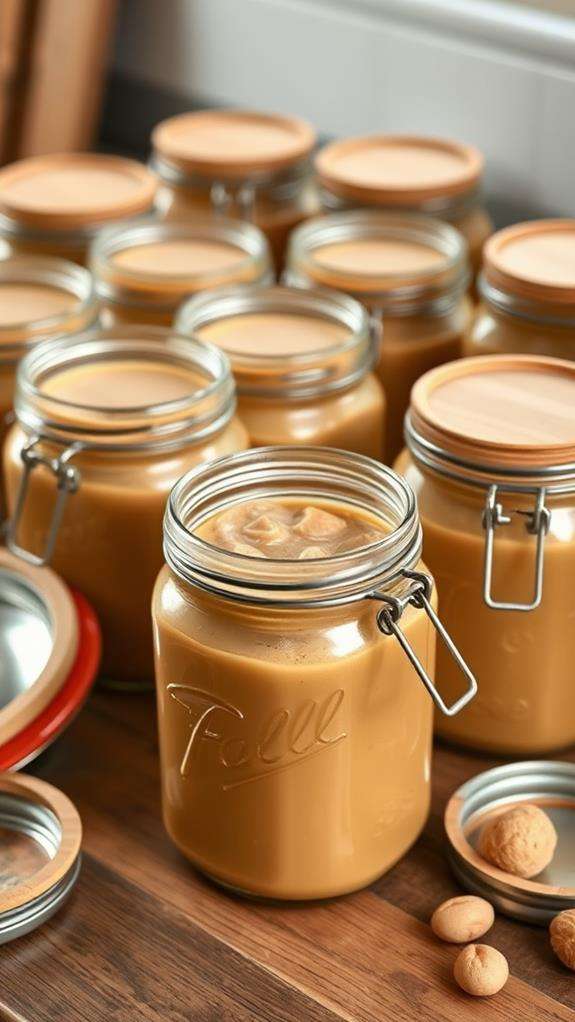
When choosing containers for your fresh ground peanut butter, you'll need to decide between air-tight glass jars, which offer superior protection against oxidation, and high-quality plastic containers with reliable seals. Glass containers are your best option since they're non-porous and won't absorb any oils or odors, helping maintain the peanut butter's freshness longer than plastic alternatives. While both types can work effectively, you'll want to guarantee whichever container you select has a tight-fitting lid and is specifically designed for food storage, preferably with features like rubber gaskets or vacuum-seal capabilities to minimize air exposure.
Air-Tight Versus Glass Options
Properly storing fresh ground peanut butter requires choosing between air-tight containers and glass options, each offering distinct advantages for preserving quality. You'll find that air-tight containers excel at preventing oxidation and moisture intrusion, which are the primary factors that can compromise your peanut butter's freshness. Glass containers, while equally effective when properly sealed, offer the added benefit of being odor-resistant and easier to clean.
When selecting your storage container, consider these key factors:
- Seal quality: Your container must create a complete barrier against air, regardless of whether it's plastic or glass.
- Size appropriateness: Choose a container that minimizes empty space above the peanut butter to reduce air exposure.
- Material durability: Confirm your chosen container can withstand repeated cleaning and continued use.
You'll want to transfer your fresh ground peanut butter to your chosen container immediately after purchase or grinding. Whether you opt for air-tight or glass containers, remember to store them in a cool, dark place. It's important to regularly inspect your stored peanut butter for any changes in consistency or smell, as these can be early indicators of spoilage.
Best Containers For Freshness
Selecting the right container specifically for fresh ground peanut butter can make a significant difference in maintaining its quality and extending its shelf life. You'll want to focus on containers that provide an exceptional seal against air and moisture, which are the primary factors in spoilage.
When you're choosing containers for your fresh ground peanut butter, opt for glass jars with tight-fitting lids or BPA-free plastic containers designed for airtight storage. These materials won't interact with your peanut butter and will maintain a reliable seal throughout multiple uses. You'll need to guarantee the container's opening is wide enough for easy scooping while still providing an effective seal when closed.
While you might be tempted to keep your fresh ground peanut butter in its original packaging, it's not the best choice for long-term storage. Instead, transfer it immediately to your chosen airtight container, and don't forget to check it regularly for any changes in consistency or smell. For best results, store your container in a cool, dark place or in the refrigerator, where the controlled environment will help preserve freshness even longer.
Oil Separation Solutions
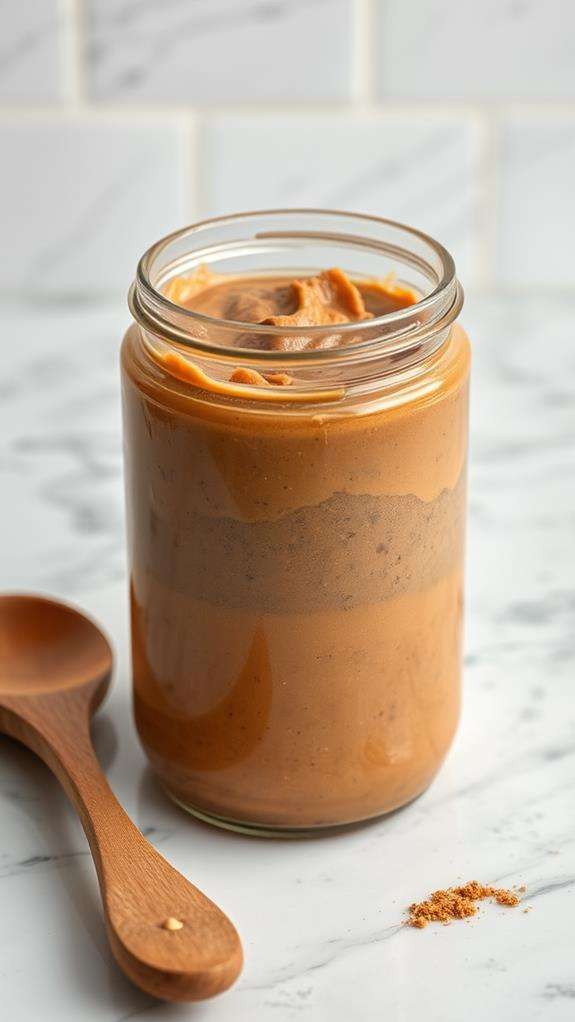
Fresh ground peanut butter naturally separates over time, but several effective solutions can help maintain its consistency. When you notice oil separation occurring, you'll want to implement specific storage and handling techniques to preserve your peanut butter's texture and guarantee a relatively long shelf life.
Here are three proven methods to manage oil separation in your fresh ground peanut butter:
- Store your jar upside down in a cool place, allowing the oil to naturally redistribute through the peanut butter instead of pooling at the top
- Refrigerate your peanut butter immediately after thorough mixing, which slows separation and extends freshness for up to three months
- Transfer your ground peanut butter to an airtight container and stir thoroughly before each storage to maintain consistent texture
Before using your peanut butter, you'll need to give it a good stir to reincorporate any separated oil. If you're grinding your own peanut butter, mix it thoroughly right after grinding, as this initial combination helps establish a more stable consistency. Remember that while oil separation is natural, proper management techniques can notably reduce its occurrence and maintain your desired texture.
Extending Freshness Tips
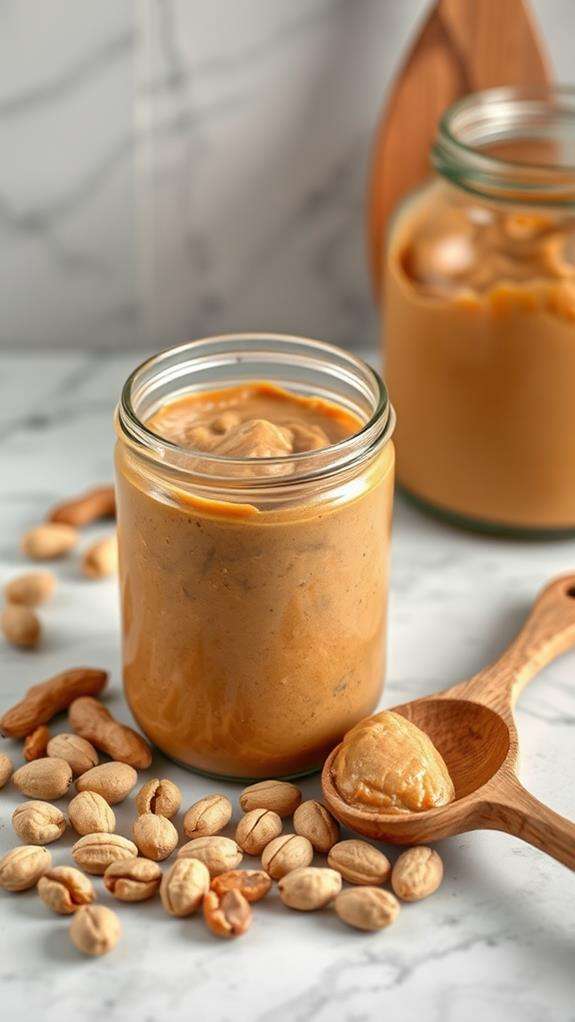
To keep your fresh ground peanut butter at its best, you'll want to choose an airtight glass or BPA-free plastic container that's properly sized for your portion, minimizing the amount of air trapped inside. Maintaining proper temperature control is essential, so you should store your container in the refrigerator at around 40°F (4°C), away from light and heat sources that could trigger premature spoilage. When handling your peanut butter, always use clean, dry utensils and avoid introducing any moisture or food particles, as these can become breeding grounds for bacteria and reduce your peanut butter's shelf life.
Proper Container Selection Tips
Proper container selection stands at the forefront of maintaining your fresh ground peanut butter's quality and shelf life. When you're choosing the right storage solution, you'll want to focus on containers that provide maximum protection against environmental factors that can compromise your peanut butter's freshness.
To store fresh ground peanut butter effectively, consider these essential container characteristics:
- Airtight sealing capabilities that prevent oxidation and moisture from entering, which will greatly extend your peanut butter's shelf life and maintain its original texture.
- Opaque or dark-colored materials that shield the contents from light exposure, protecting the oils from degradation and preventing rancidity.
- Non-porous surfaces, such as glass, that won't retain flavors or odors from previous contents, ensuring your peanut butter maintains its pure taste.
Don't rely on the original packaging for long-term storage, as it might not provide adequate protection. Instead, transfer your fresh ground peanut butter to a dedicated container that meets these criteria. Remember to regularly check your storage containers for signs of wear or damage that could compromise their sealing ability, replacing them when necessary to maintain ideal freshness.
Temperature Control Matters
Temperature plays a critical role in preserving your fresh ground peanut butter's quality and preventing premature spoilage. To maximize the shelf life of peanut butter, you'll want to maintain a consistent storage temperature below 40°F (4°C), which is easily achieved in your refrigerator. This cold environment considerably slows down the oxidation process that leads to rancidity.
When you're practicing proper temperature control, you'll notice your fresh ground peanut butter can last between one to three months when refrigerated, compared to a much shorter duration at room temperature. Don't forget to monitor your refrigerator's temperature regularly, as fluctuations can impact the product's longevity. You'll know your temperature control is effective when your peanut butter maintains its original texture and aroma.
Keep your peanut butter container away from heat sources, even when it's in the refrigerator. Place it toward the back of your fridge, where temperatures tend to be more stable, rather than in the door where frequent opening and closing can create temperature variations. If you notice any unusual changes in consistency or smell, these could be signs that temperature control hasn't been ideal.
Clean Handling Practices
Beyond temperature control, maintaining clean handling practices will greatly impact your fresh ground peanut butter's longevity. When you're dipping into your jar, it's vital to use clean utensils every time, as introducing contaminants can markedly reduce how long your peanut butter goes before spoiling. Cross-contamination from used knives or spoons can introduce bacteria and other unwanted substances that accelerate deterioration.
To make certain your fresh ground peanut butter stays safe and delicious, follow these essential handling guidelines:
- Always use a clean, dry spoon or knife each time you scoop out peanut butter, avoiding the temptation to double-dip
- Wipe the rim of the container clean before sealing to prevent crusty buildup that can compromise the airtight seal
- Keep the lid tightly closed when not in use, and don't leave the container open for extended periods
Remember to check your peanut butter regularly for signs of spoilage, even with proper handling. If you notice any unusual odors, mold growth, or changes in texture, it's best to discard the product immediately rather than risk consuming contaminated peanut butter.
Common Storage Mistakes
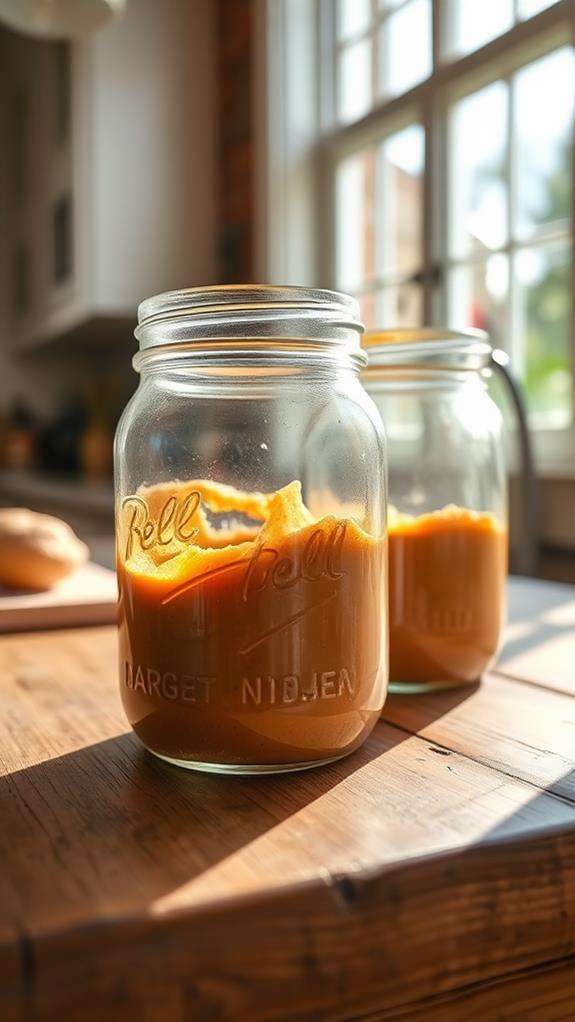
Many peanut butter enthusiasts make critical storage mistakes that can turn their fresh ground delight into a spoiled disappointment. If you're keeping your fresh ground peanut butter in its original packaging without transferring it to an airtight container, you're allowing air and moisture to compromise its quality. Additionally, failing to keep it stored in a cool environment, particularly in the refrigerator after opening, can slash its shelf life from several months to mere weeks.
You might be unknowingly sabotaging your peanut butter's longevity by placing it near heat sources like your stove or in direct sunlight. These conditions accelerate rancidity and degrade the oils naturally present in the product. Another common oversight is not monitoring the peanut butter's condition regularly. You should check for unusual changes in texture, smell, or excessive oil separation, which can indicate spoilage. Pay attention to how you handle the product, too – using dirty utensils or double-dipping introduces contaminants that speed up deterioration. By avoiding these storage mistakes and maintaining proper storage conditions, you'll greatly extend your peanut butter's freshness and enjoy its natural qualities longer.
Best Temperature Range
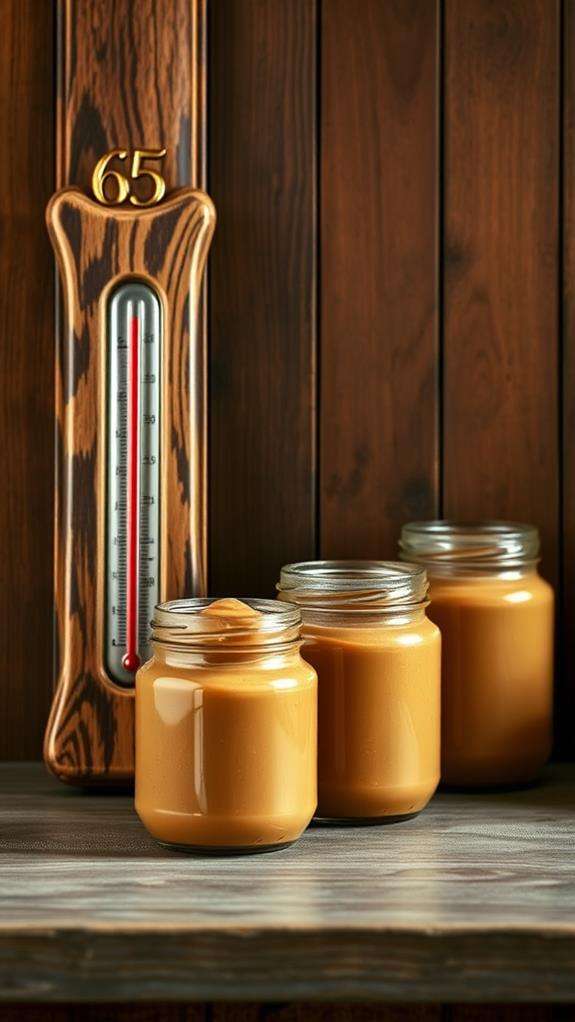
Understanding the ideal temperature range for fresh ground peanut butter can make a notable difference in its shelf life and quality. When you're storing your freshly ground peanut butter, maintaining a consistent storage temperature below 70°F (21°C) is essential to prevent spoilage and maintain its natural properties.
For peak preservation, here's what you need to know about temperature control:
- Keep your fresh ground peanut butter in the refrigerator at 32°F to 40°F (0°C to 4°C) to maximize its shelf life and prevent oxidation.
- If you're storing it in your pantry, make sure the temperature stays below 70°F (21°C) to maintain quality, though refrigeration is strongly recommended.
- Avoid exposing your peanut butter to temperature fluctuations, as this can accelerate oil separation and affect texture.
You'll notice that refrigerated storage can extend your fresh ground peanut butter's shelf life to 1-3 months, compared to a notably shorter duration at room temperature. The cooler temperature effectively slows down the natural processes that lead to rancidity, helping maintain both flavor and consistency. Remember, proper temperature control isn't just about preservation—it's about maintaining the quality you expect from fresh ground peanut butter.
Daily Handling Guidelines
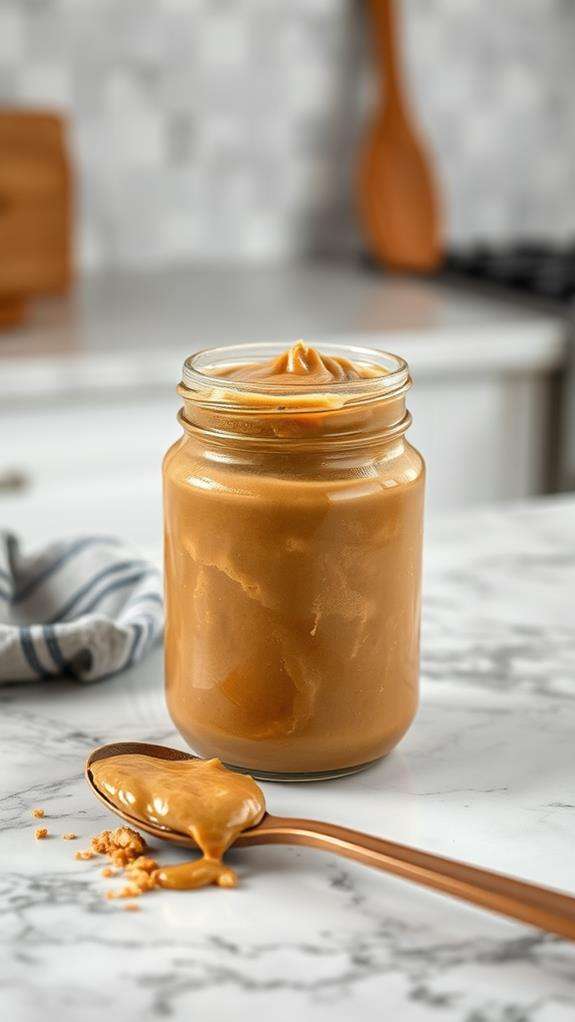
Proper daily handling of fresh ground peanut butter greatly impacts its longevity and quality. When you're using your freshly ground peanut butter, always reach for a clean spoon or knife to prevent introducing contaminants that can speed up spoilage. You'll want to make this a consistent part of your daily handling routine, as even small amounts of food particles or moisture can compromise the product's shelf life.
Keep a close eye on your peanut butter's appearance and aroma each time you use it. You're looking for spoilage indicators like an off-putting smell, unusual coloring, or changes in texture that seem out of the ordinary. Store your peanut butter in an airtight container after each use, and don't leave it sitting out on the counter where it can be exposed to heat, light, or humidity. If you notice any oil separation, that's normal – just give it a good stir before using. Make sure you're sealing the container properly after each use, as exposure to air can lead to oxidation and affect both taste and shelf life. When in doubt about freshness, it's better to err on the side of caution and discard the product.
Frequently Asked Questions
Does Fresh Ground Peanut Butter Go Bad?
Yes, fresh ground peanut butter can go bad, and you'll need to watch for specific signs of spoilage. When stored in your refrigerator, it typically stays fresh for 1-3 months. You'll know it's spoiled if you notice a rancid smell, unusual color changes, or an extremely dry texture. While oil separation is normal and shouldn't worry you, any mold growth or off-putting odors mean it's time to toss it out.
How Long Does Fresh Homemade Peanut Butter Last?
Your homemade peanut butter will last about 1 month in the refrigerator when stored properly. You'll get the best quality and freshness during this time. If you're storing it in an airtight container, you can expect it to maintain its texture and flavor for up to 3 months. Don't worry about oil separation – that's natural. However, if you want to preserve it longer, you can freeze it for up to 6 months.
How Long Does Fresh Market Peanut Butter Last?
Ever wondered how to keep your fresh market peanut butter at its best? You'll get the longest shelf life, about 1-3 months, when you store it in the refrigerator after opening. If you're keeping it at room temperature, you'll want to use it within a month. Watch for signs of spoilage like odd smells, color changes, or unusual texture. For the best results, you'd want to refrigerate it immediately after purchasing and keep the lid tightly sealed.
Does Whole Food Fresh Ground Peanut Butter Need to Be Refrigerated?
Yes, you'll need to refrigerate your whole food fresh ground peanut butter after opening it. Since it's made without preservatives, keeping it cold helps prevent rancidity and extends its shelf life. Store it in an airtight container at temperatures below 50°F (10°C) to maintain its quality. You'll want to check it regularly for any changes in smell or texture, as this type of natural peanut butter can spoil more quickly than commercial varieties.





